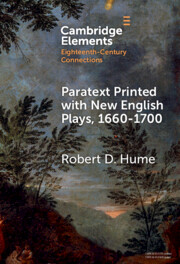187 results
4 - The B Word
-
- Book:
- Bitch
- Print publication:
- 27 June 2024, pp 98-130
-
- Chapter
- Export citation
4 - ‘Pornography’, ‘Obscenity’, and the Suppression of Libertine Literature
-
-
- Book:
- The Cambridge World History of Sexualities
- Published online:
- 26 April 2024
- Print publication:
- 16 May 2024, pp 71-93
-
- Chapter
- Export citation
Chapter 10 - Government, Policy, and Censorship in Post-war British Theatre
- from Part IV - Theatre and State
-
-
- Book:
- The Cambridge Companion to British Theatre since 1945
- Published online:
- 14 March 2024
- Print publication:
- 21 March 2024, pp 209-228
-
- Chapter
- Export citation
11 - The Reception of the Protestant Reformation in the Iberian Peninsula
-
-
- Book:
- Reformations Compared
- Published online:
- 14 March 2024
- Print publication:
- 21 March 2024, pp 242-265
-
- Chapter
- Export citation
3 - Silencing Sex
-
- Book:
- Before the Word Was Queer
- Published online:
- 14 March 2024
- Print publication:
- 21 March 2024, pp 84-116
-
- Chapter
- Export citation
Planting the Republic: State Regulation of the Discourse on Food Shortages in Public Communication in Early Czechoslovakia (1918–21)
-
- Journal:
- Austrian History Yearbook , First View
- Published online by Cambridge University Press:
- 08 March 2024, pp. 1-14
-
- Article
- Export citation
25 - Nothing Could Be More Hollywoody
- from Part IV - The Golden State
-
- Book:
- Soviet Adventures in the Land of the Capitalists
- Published online:
- 18 January 2024
- Print publication:
- 22 February 2024, pp 274-290
-
- Chapter
- Export citation

Paratext Printed with New English Plays, 1660–1700
-
- Published online:
- 19 December 2023
- Print publication:
- 01 February 2024
-
- Element
-
- You have access
- Open access
- HTML
- Export citation
2 - Growing Supplies
-
- Book:
- A Colonial Book Market
- Published online:
- 16 November 2023
- Print publication:
- 30 November 2023, pp 74-125
-
- Chapter
- Export citation
5 - “Weird Book” – Book Censorship Case Study
-
- Book:
- Understanding the Role of Equity
- Published online:
- 12 October 2023
- Print publication:
- 26 October 2023, pp 61-68
-
- Chapter
- Export citation
Introduction
-
- Book:
- Wartime Shakespeare
- Published online:
- 12 October 2023
- Print publication:
- 26 October 2023, pp 1-32
-
- Chapter
- Export citation
Introduction - Seeds of Sedition
-
- Book:
- Libels and Theater in Shakespeare's England
- Published online:
- 05 October 2023
- Print publication:
- 19 October 2023, pp 1-28
-
- Chapter
- Export citation
Chapter 6 - Turning Plays into Libels: Satire and Sedition in Jonson’s Poetaster
- from Part II - Libels on the Elizabethan Stage
-
- Book:
- Libels and Theater in Shakespeare's England
- Published online:
- 05 October 2023
- Print publication:
- 19 October 2023, pp 172-203
-
- Chapter
- Export citation
Chapter 4 - Libel, Equity, and Law in Sir Thomas More
- from Part II - Libels on the Elizabethan Stage
-
- Book:
- Libels and Theater in Shakespeare's England
- Published online:
- 05 October 2023
- Print publication:
- 19 October 2023, pp 115-143
-
- Chapter
- Export citation
Chapter 2 - Mobilising the Nation
- from Part I - Mobilising for War
-
-
- Book:
- The Cambridge Companion to British Theatre of the First World War
- Published online:
- 19 October 2023
- Print publication:
- 19 October 2023, pp 33-52
-
- Chapter
- Export citation
Chapter 7 - War on the Popular Stage
- from Part II - Theatre during the War
-
-
- Book:
- The Cambridge Companion to British Theatre of the First World War
- Published online:
- 19 October 2023
- Print publication:
- 19 October 2023, pp 128-143
-
- Chapter
- Export citation
Chapter 11 - Resistance and Objection
- from Part II - Theatre during the War
-
-
- Book:
- The Cambridge Companion to British Theatre of the First World War
- Published online:
- 19 October 2023
- Print publication:
- 19 October 2023, pp 192-206
-
- Chapter
- Export citation
Chapter 3 - Challenging Times
- from Part II - Theatre during the War
-
-
- Book:
- The Cambridge Companion to British Theatre of the First World War
- Published online:
- 19 October 2023
- Print publication:
- 19 October 2023, pp 55-73
-
- Chapter
- Export citation
Chapter 12 - Reflecting on the War
- from Part III - The Memory of War
-
-
- Book:
- The Cambridge Companion to British Theatre of the First World War
- Published online:
- 19 October 2023
- Print publication:
- 19 October 2023, pp 209-224
-
- Chapter
- Export citation
Chapter 6 - Sexual Liberation Movements
- from Part I - Ideologies and Movements
-
-
- Book:
- The Cambridge Companion to the Twentieth-Century American Novel and Politics
- Published online:
- 07 October 2023
- Print publication:
- 12 October 2023, pp 94-108
-
- Chapter
- Export citation



